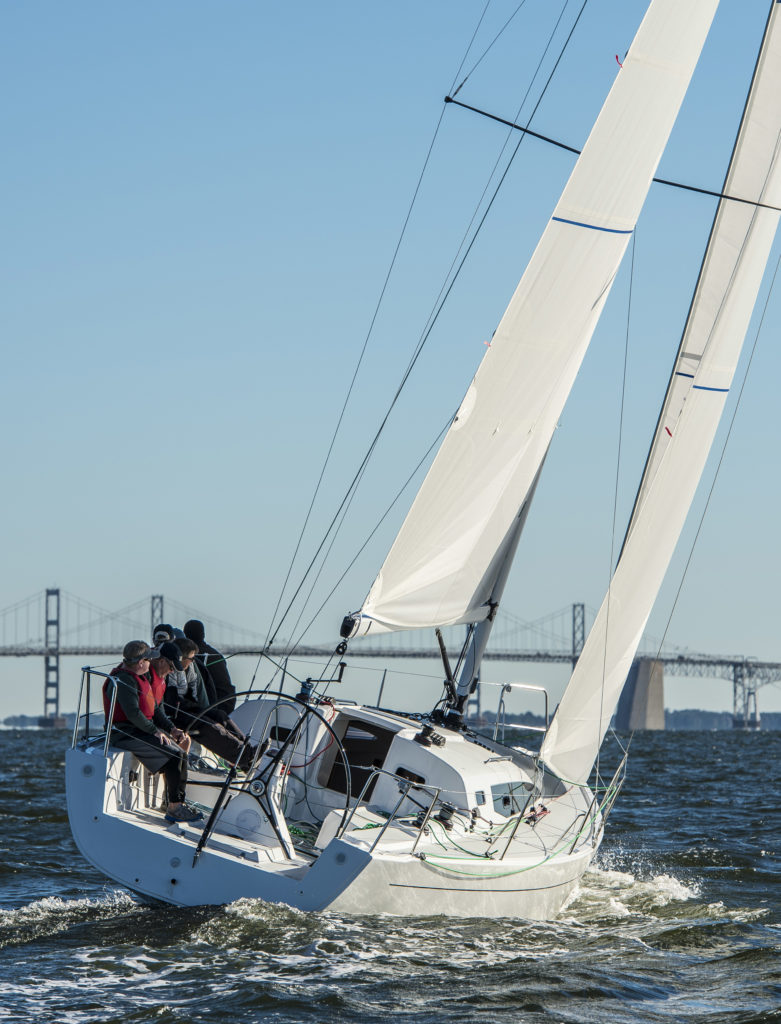For J Boats, it’s simple enough to tack an “E” onto a model and create an entirely new range of boats, especially with its European builder in Les Sables d’Olonne, France, driving the company’s evolution. J Boats designer Al Johnstone says the “E” is for “evolution” or “elegance,” but it could be for “Euro,” as that’s the market for which the design was conceived. Europeans, says Johnstone, prefer a slightly more upscale and detailed interior look, more windows, and a boat they’ll race and happily cruise. Racing aspirations may list second in the brochure, but the J/112E is perfectly suited to the racecourse. The judges say it has “that traditional stiff, upwind feel of a J Boat.” One might be tricked into thinking the J/112E is a knockoff of the successful J/111 one-design more familiar to U.S. racers, but it’s an entirely new boat from stem to stern. It’s shorter than the J/111 by 6 inches, but it’s bigger everywhere else — at the waterline, at max beam, and in the interior with more headroom.
It’s 2,000 pounds heavier as well, but has a longer boom and more sail area than the J/111, which Johnstone says will earn it a PHRF rating somewhere in the low 50s. There’s no conflict for the J/111 class either, says Johnstone, as the J/112E is absolutely a cruising boat. But under the hands of a competent crew, it will be a handicap-racing sleeper. To prove the point, Chicago-area dealer Rich Stearns finished second with one in Chicago YC’s 2016 Race to Mackinac (Division 5).
“The helm has excellent feel,” says Chuck Allen. “In 10 to 12 knots, it definitely sails like a J Boat, with the traveler up, sheet eased and twisted off to get it rumbling. There’s great bite in the rudder — we tried hard to wash it out, but it just bit every time.”
The J/112E’s standard keel is a 7-foot iron fin with a lead shoe encased on the bottom. The boat is vacuum-infused with balsa in the hull and foam in the deck. Bulkheads are solid walnut and the floorboards are synthetic, but teak-and-holly is an option. The keel grid is heavily reinforced glass, and the chainplates are bolted onto the outside of the hull (with cover plates), which Johnstone says provides a better tie-in to the hull structure.
On deck, there’s an adjustable backstay (hydraulic would be an upgrade) and an upgraded composite wheel for that black-is-fast look. The winches are recessed to provide proper leads, the traveler is recessed to eliminate a tripping hazard, and underdeck mainsheets exit from the cockpit sidewalls. It’s a system that Johnstone says allows them to avoid using the typical German mainsheet system, which requires the use of a winch in light air. The more direct-to-hand mainsheet system, says Allen, with a fine and gross tune, provides much better feel in winds under 15 knots.
“Like every J Boat we’ve seen in the past, this one was presented properly, even though it came straight off the ship,” says Greg Stewart. “The sails were good, the rig was right, and it was ready to sail. It seems like a bigger boat than 36 feet, and it isn’t your standard J Boat interior, which is nice. It’s a great-looking boat, at the dock and on the water.”
All the judges agreed that the J/112E is suited to weeknight club racing, whether the spinnaker comes out of a bag on deck or on a top-down furler as tested. Adding a code zero to the inventory, says Allen, would be a wise choice for cruising and longer point-to-point races.

More Information
Best Crossover:
J/112E
Designed for:
Club racing
Cruising
The judges liked:
Upwind performance
Appealing Design
Essentials-only interior
Required crew:
Five to six
Price as tested:
$280,000









